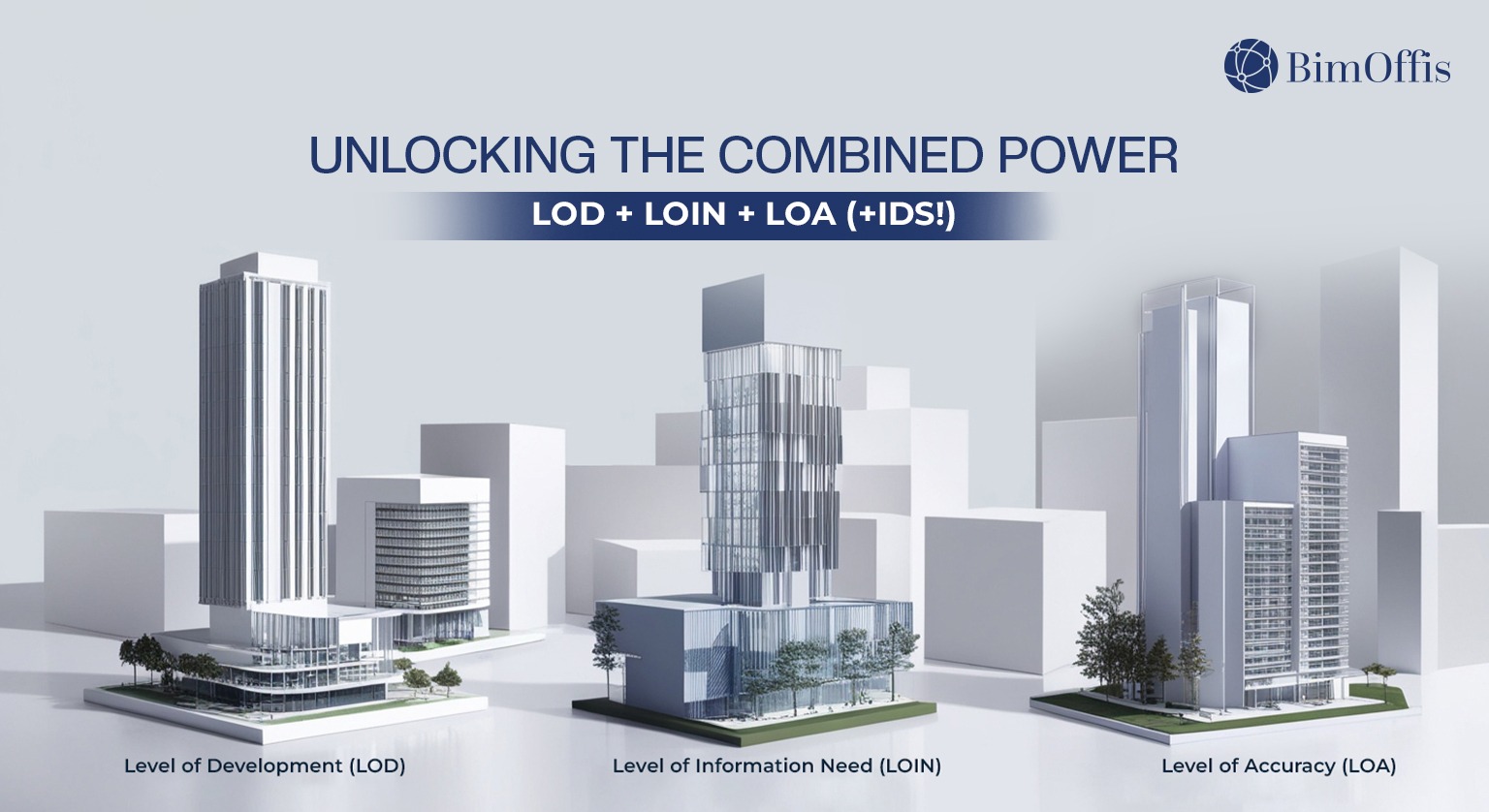Building Information Modeling (BIM) exists as a realm where data represents the most prominent resource. Raw data serves no purpose unless project stakeholders understand its context along with its intended usages. The managerial framework of BIM data becomes effective through the combined implementation of Level of Development (LOD), Level of Information Need (LOIN) as well as Level of Accuracy (LOA). We at BimOffis, realizes the essential nature of these concepts which deliver success in BIM projects and we provide assistance for reaching their combined impact. Additionally this article presents Information Delivery Specification (IDS) as a crucial parameter for BIM models.
LOD (Level of Development) establishes the methods to define BIM geometric representations.
LOD describes the geometric detail and completeness of BIM elements at different stages of the design and construction process. The evolution of your model receives guidance through this document which provides standardized detail requirements during each development stage. Gaining adoption from the AIA (American Institute of Architects) is a widely accepted LOD framework which defines progress levels from Conceptual at LOD 100 to Construction at LOD 400.
Project teams can use knowledge about LOD to achieve the following benefits:
- The project plan should define precise detail standards so teams avoid unnecessary work without important information being absent.
- A common terminology should be established for describing model maturity to minimize confusion and misreadings in project communication.
- Risk management strategies ensure that the model serves its intended purpose in every stage which reduces expensive rework occurrences.
Level of Information Need (LOIN): Specifying the Data
The geometric aspects receive attention from LOD but LOIN concentrates on providing appropriate information about those geometric elements. The required data specifications for particular business use cases including cost estimation and energy analysis as well as facility management. LOIN provides more than just data access by defining the appropriate information which becomes available at the right moment. A well-defined LOIN helps:
- Data collection efforts should be focused on essential information acquisition to reduce time and resource usage.
- The data delivery system supports the development of informed decisions through all project stages.
- Software’s ability will improve when information exchanges without technical constraints between various software platforms that serve stakeholders.
Level of Accuracy (LOA): Ensuring Data Reliability
LOA specifies the maximum allowable deviation that exists between actual model information and the intended standards. The framework checks data reliability and detailing to confirm suitability for its purpose. The LOA needed for material properties must be higher than required for visual renderings in a structural analysis. LOA helps to:
- Clear data is required to be established to reduce mistakes and data inconsistency problems.
- Project expenses decrease when data reliability is established during initial stages to prevent further project corrections.
- Accurate project data allows you to trust your analytical decisions since the data provides confidence in your strategic choices.
The Synergistic Power of LOD, LOIN, and LOA
The united power of these three principles forms an extensive system for BIM data management. The accurate definition of geometric details belongs to LOD while LOIN determines needed information and LOA maintains correct information accuracy. A project team achieves success through the examination of these three aspects in combination.
- The organization should implement optimized workflows to enhance data production and administration.
- The system promotes better teamwork by enabling stakeholders to exchange information and share data effectively.
- The use of BIM enables better project completion through higher quality results that meet deadlines and budget targets.
The Rise of Information Delivery Specifications (IDS)
An Information Delivery Specification (IDS) enables project teams to achieve added control through clear specifications about data delivery. Information Delivery Specifications operate as a regulatory guide that establishes both format-side and unit-part and rule-based assessment requirements for data distribution. By automating data checking tasks IDS helps projects maintain uniformity across multiple projects. Ironically IDS functions as the directive for application while LOIN prescribes the reasons and LOD establishes the parameters.
BimOffis: Your Partner in BIM Success
We know that understanding and implementing LOD, LOIN, LOA, and IDS can be perplexing. BimOffis is experienced in areas such as BIM consultancy model creation, and management; thus, we will guide you through relevant concepts so that BIM can help you extract desired value. Our experts will collaborate with you to create a tailored BIM strategy that meets your end goals and magnifies your ROI.
Isn’t it time you took your BIM endeavor far above the high bar? Contact us for a free consultation to see how BimOffis can carry you to BIM excellence. Don’t just model; manage your information! Let BimOffis partner with you in unlocking the collective power of LOD, LOIN, LOA, and IDS.






